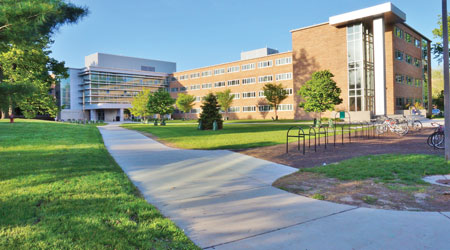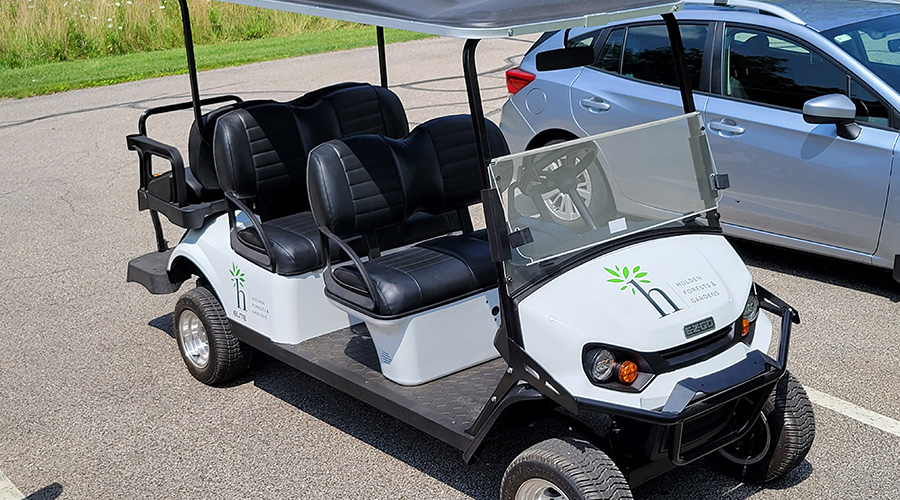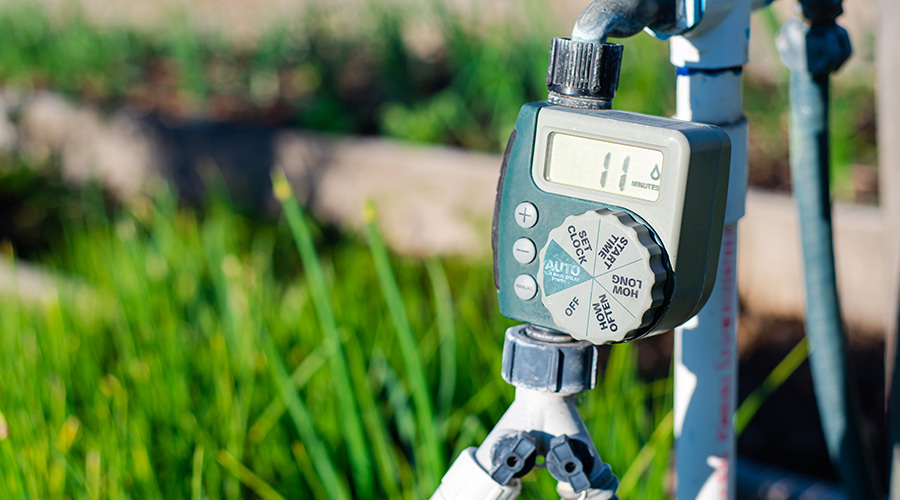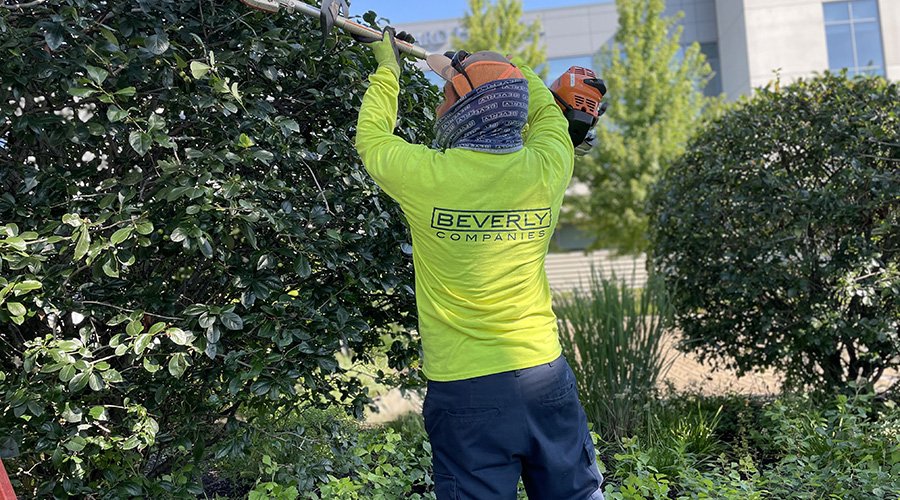 Michigan State University’s landscape services department maintains about 1,800 acres that includes 600 acres of turf, 50 acres of planting beds and 22,000 trees.
Michigan State University’s landscape services department maintains about 1,800 acres that includes 600 acres of turf, 50 acres of planting beds and 22,000 trees.Utility Vehicles Extend Reach, Expand Efficiency
Fleet enables grounds crews to more cost-effectively maintain Michigan State University’s 2,200-acre campus.
By Dan Hounsell, senior editor
Utility vehicles are designed to expand the abilities of grounds crews carrying out landscaping tasks. The vehicles can carry personnel and materials to areas too rough for a truck to access or too far away for workers to walk. So when those areas and tasks are on a 2,200-acre campus, range and maneuverability come in especially handy.
“They’re transportation for our maintenance teams, delivering equipment and supplies,” says Matt Bailey, landscape services manager with Michigan State University. “The crews carry their weed whips and gas cans and backpack blowers and pruners. They're basically transportation for getting them to the tasks because we have such a big campus.”
Campus considerations
The Michigan State campus in East Lansing hosts about 50,000 students, and its turf and landscaped areas present Bailey and his department with a range of challenges.
“We've got a lot of wood, lots and natural areas on campus,” he says. “The Red Cedar River runs right through the middle of our campus.”
The 85-person department maintains about 1,800 acres that includes 600 acres of turf, 50 acres of planting beds, and 22,000 trees. The department also is responsible for 220 acres of parking lots, 60 lane miles of roads and 115 miles of sidewalks.
“We do all the restoration, the plantings, the seeding, the grading and topsoil placement,” he says. “As far as hard surfaces, we do all of our own line striping and our own street sweeping, ramp cleaning, sign installation, sign maintenance. We employ seven arborists, and we maintain our own campus arboretum. We try to maintain or prune every tree once every five years. Our gardening units maintain our plant beds and install all of our annual flowers. We also do all the mowing.”
The department also oversees the campus nursery, which supplies plant materials and trees for our campus.
“We have our own supply yards, so any trees we cut down on campus, we grind that up into wood mulch,” he says. “Trees that are cut from our arboretum that are damaged due to wind storms are repurposed, and the wood is used for furniture. That lumber is sold in our surplus stores. My desk is made from a tree that was along the Red Cedar River.”
Focus on the fleet
To carry out this variety of grounds tasks for the sprawling campus, the department relies on an arsenal of equipment that includes 25 diesel and electric utility vehicles.
“Overall, we have about 140 pieces of equipment, and 25 of those are utility vehicles that I would classify as a golf cart — a battery-operated golf cart,” Bailey says. “We have four-wheel-drive (rough terrain vehicles) that we use. They're year-round because they're four-wheel drive.”
The department’s fleet of utility vehicles at one time numbered about 30.
“We've minimized our fleet quite a bit,” he says. “We had a little of what we call fleet creep, and we realized that everybody doesn't need a truck. So we installed GPSs on all of our vehicles, and we looked at utilization rates, idle time, those kinds of things. It has really made us see how equipment has been used.”
The year-round nature of campus maintenance and the harsh Midwest winters crews must endure affect the makeup of the utility vehicle fleet.
“The majority of our golf carts have doors and heaters on them,” Bailey says. “We put plows and salters on in the winter for sidewalks, so they're kind of our four-season vehicles. A good portion of the golf carts, the battery-operated golf carts, are stored during the winter season.
“We maintain the campus throughout the winter, and we need to have a four-wheel drive piece of equipment with heat in the cab, and that's a struggle to find that piece of equipment that's more sustainable — a battery-operated four-wheel drive that we can put a plow on. That's where we struggle. We haven't found anything that fits that need totally, so that's why we're constantly looking and demoing and bringing in new equipment to try out.”
Managing the fleet
Ensuring that the fleet of utility vehicles is available and reliable for crews also is an in-house task.
“We purchase and maintain all of our own equipment, where a lot of other places will send it out or just have somebody who does oil changes,” Bailey says. “We do engine rebuilds. We've got five hoists and a pretty intricate shop area. We have a coordinator who orders all of our parts and creates work orders for the equipment as they come in, including PMs and inspections.
“Our mechanics have seen everything in terms of damage, and they do what they can to mitigate things as far as fabricating brackets to protect lighting and backup cameras and those types of tweaks. The campus is very hard on vehicles as far as curbs and roads and a lot of miles. The seasonal staff members aren't always careful with equipment. It's not their vehicle, so they're a little tough on them. The vehicles have to be commercial-grade quality.”
Bailey says the department’s fleet manager, along with four mechanics, are central to the process of replacing utility vehicles. The first step in the process, though, is determining whether replacement is even necessary.
“We've really taken a close look at the first step in the replacement processes: Do we actually even need to replace it?” Bailey says. “Are there other opportunities where we can find multiple uses out of this replacement? We're looking at it and saying, ‘I know this was supposed to replace that in 10 years, but it's in relatively good shape. Let's push it out to 12 years.’
If the decision is to replace the vehicle, the fleet manager starts the process.
“We have a really intricate replacement process for equipment,” Bailey says. “He brings in one of our lead mechanics, the operator of the vehicle, and the operator’s supervisor, and they go through a process of reviewing the piece of equipment that's up for replacement. How did this work? Did it meet all your needs?
“We look at sustainability. Do we need to replace those pieces of equipment? Are there other options that we currently have that we're not using? Then we get input from the end user, and we go through the bidding process.”
The department’s vehicles are on a 10-year replacement rotation.
“We have a rental rate for that golf cart, and we are able to look back at data to see our average cost to maintain a golf cart for a year,” Bailey says. “What's the initial cost? What's the replacement value? Then at that 10-year mark, the equipment is decommissioned and sent over to our surplus store, where it'll be auctioned off to the highest bidder. We'll bring in a new piece of equipment and outfit it, and it's implemented back into the department.”
Changing campus
Among the challenges Bailey and his department face is tailoring their fleet of utility vehicles and other grounds care equipment to a campus that is evolving in ways that affect the type and amount of required maintenance.
“We are moving to a lot of meadow areas and natural areas, increasing our riparian buffer along the Red Cedar to mitigate erosion and runoff,” Bailey says. “We're adding more pollinators. We've established the banks of the Red Cedar as a pollinator corridor, so we've added three pollinator gardens along the river.
“We don't have a goal as far as wanting to have a certain number of acres of natural areas in the future. Basically, what we're trying to do is look for opportunities to minimize emissions and increase our carbon sequestration and those types of things. We established a tree replacement protocol for adding 300 trees a year onto campus so we can really help increase carbon sequestration.”
As always, finances play a central role in equipment decisions.
“We’re using more sustainable practices as far as maintenance and turf, especially minimizing the acreage that we're mowing,” he says. “We reduced staffing due to reduced budgets, so we were able to reduce the mowing areas, and that worked out really well. It was kind of a catalyst to move forward with some of those things.”
The department feels the impact all the way down to the equipment specification process.
“We're working with the American Green Zone Alliance to add more battery-reducing two-stroke and diesel equipment and add more battery-operated equipment for normal maintenance operations,” he says, referring to the national organization — agza.net — that recognizes properties on which routine grounds maintenance is performed with low-impact equipment and people-powered tools. “That doesn't mean we can't come in there and cut a tree down with a two-stroke saw, but that's not a daily maintenance thing. We're adding a battery-operated golf cart, a battery backpack blower, battery weed whips, battery mowers. We’re also implementing robotics, such as autonomous mowers, to get the accreditation.”
Related Topics:












